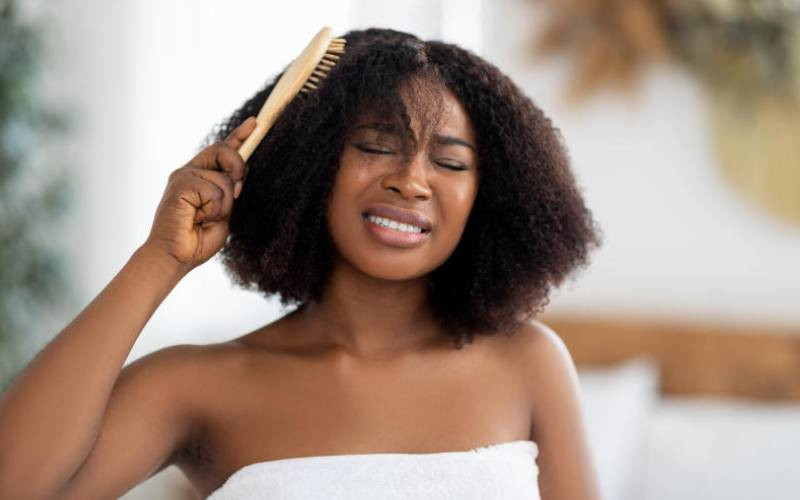
Some of us love the natural hair movement, but our hair doesn’t seem to support us. Rather than put your stubborn curls on fire with a toxic relaxer, there’s another way to keep your natural hair: dreadlocks. Most women are hesitant to rock dreadlocks because of the negative stereotypes, but I can tell you that regardless of which kind of hair you have, as long as you are black people will keep talking about it so just do you. I’ve never seen white people shamed for their hair, let alone for wearing dreadlocks – but that’s another discussion all together.
You can see dreadlocks as another option for those who want to go natural. It’s easier to maintain than free natural hair and certainly consumes less product. This doesn’t mean you shouldn’t take care of them at all. Anyway, locs can be started from any length and this is how you can get started as well.
1.Comb coils (Traditional)
This is the most common way people start their locs, hence why it's also known as the traditional style. The process is simple: you take a strand of gel or wax and coil it with a comb.
Drawbacks: While shorter lengths will lock fairly quickly with this method, starting locs with comb coils on longer lengths of hair will take longer to lock because the inside of the comb coil is hollow and the coil has to mesh together internally first to begin loc’ing.
What to Expect: Comb coils can be sensitive to water with soft textures so you want to be sure to only wet them when you’re shampooing them to prevent them from coming undone. Once the ends are sealed and there is a bud on the end, this method “looks like locs” the quickest.
- Protective hairstyles to try this rainy season
- Weaving through the rain
- Under Beyonce's wig; Stars and their hair
- How to pamper your natural mane
Keep Reading

2.Sisterlocs/ Interlocking
If there is one particular dreadlock style that is popular in Kenya, it’s this one. Sisterlocs are often really small in size and they can be made using a crochet or comb to interweave the strand itself.
Drawbacks: The resulting locs are often micro to small in size. Also, depending on your texture of hair, it can take 6 months to 2+ years before your hair is fully locked. They can also take a long time (at least a day or two) to maintain.
What to Expect: Interlocking basically creates the internal structure of the loc first and then all the shed hairs accumulate around that matrix, and because of this the locs will swell in size first, as they’re maturing, and then shrink down in size.

3.Two Strand Twists
Most people who opt for this already have pretty long hair. It’s exactly how it sounds: you make twists in your hair and that’s it. The thickness of your twists will determine the thickness of your locs as they mature.
Drawbacks: The lines of the two strand twists can take 6 months – 2 years to completely disappear and produce the appearance of solid locs.
What to expect: In the beginning, your twists may unravel at the ends, so it is important to always maintain the locs from root to ends. Locs that are started with two strand twists can use palm rolling or comb twisting for maintenance.

4.Loc Extensions
For people that don’t want to go through the “ugly phase” of locs and instantly want the appearance of long, cultivated locs. You can attach loc extensions with human hair fibers, synthetic fibers, or someone else’s locs.
Drawbacks: If you use synthetic fibers to start your journey, the locs will be heavier and you’ll be limited from any coloring unless you cut the extensions off. Also, with the instantaneous cultivation of locs through extensions, you will never get the full experience of growing your hair into maturity, so it can be hard to relate to others in the loc’d community.
What to Expect: Although your extensions will be “loc’d” your hair/roots will need to go through the locking process, and anyone with locs will tell you that it includes frizz (but you skipped the hard part)!

5. Free Form
This is for the really bold ones, the ones who want to let their natural hair be free. Free forming means you start your hair organically by shampooing your hair and never detangling it again or using a curl sponge and letting your locs form on their own. Freeform locs are free to grow how they please and you don’t separate them from each other, instead you let the hair dictate the look.
Drawbacks: You never know how your locs will turn out— for some that is the beauty of the journey and others it can be unsettling and a learned appreciation.
What to Expect: You will never have to worry about your hair as long as you freeform, you literally just embrace the journey. Note that freeform locs still need to be well maintained to remain healthy; they’re not an excuse to stop taking care of your hair altogether.

 The Standard Group Plc is a multi-media organization with investments in media platforms spanning newspaper print
operations, television, radio broadcasting, digital and online services. The Standard Group is recognized as a
leading multi-media house in Kenya with a key influence in matters of national and international interest.
The Standard Group Plc is a multi-media organization with investments in media platforms spanning newspaper print
operations, television, radio broadcasting, digital and online services. The Standard Group is recognized as a
leading multi-media house in Kenya with a key influence in matters of national and international interest.



